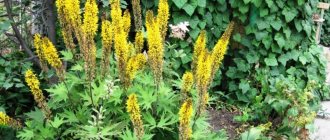Caring for homemade campanula at home
Campanula - this plant loves light but should not be placed in direct sunlight
Campanula is a delicate, but not at all whimsical flower. Growing it at home will be easy for both professionals and beginners.
Choosing location, lighting, optimal temperature
Campanula is a fairly light-loving plant. It needs a lot of light, but you should still avoid direct sunlight. Therefore, in hot summer hours it must either be removed from the window or shaded.
An excellent option for placing a campanula would be east and west windows. When placed in the south, you need to carefully monitor the amount of light that falls on the campanula. But on northern windows, campanula will not feel very good. If there is no other placement option, then try to provide the campanula with artificial lighting for several hours a day. This is especially true for the winter season.
In the warm season, the bell will feel great outdoors. It can be placed on the balcony or in the garden, but it is worth remembering that the bright rays of the sun are destructive for this plant.
Campanula tolerates temperature changes well, but feels most comfortable at 22-25 degrees in summer and 15 degrees in winter. Due to the fact that the bell adapts well to different temperature conditions, it can be safely exposed to the open air at the beginning of spring and removed only at the end of September.
Air humidity and watering indoor campanula flower
A special feature of Campanula is that it can easily survive without water for two weeks. However, in the summer heat you need to water the campanula regularly. You can do this up to twice a day, the main thing is to ensure that the soil dries out before watering. Care must be taken to ensure that water does not accumulate in the pot or tray. In winter, watering is kept to a minimum; it is enough to water the bell 2-3 times a month. When watering, you need to use soft, settled water at room temperature.
Humidity level is not very important for campanula. It will tolerate dry air well. But periodic spraying will not hurt and, most likely, will affect the development of Campanula for the better.
Choosing soil and feeding regime for campanula plants
It is best to choose loose soil for campanula so that the roots can breathe. To prepare it yourself, you need to take equal parts of leaf and peat soil.
Campanula should be fed only during the period of active growth, bud formation and flowering. At this time, you need to fertilize the bell 2-3 times a month. For feeding, complex fertilizer for flowering indoor plants, which can be found in the store, is perfect. As soon as the plant goes into dormancy mode, feeding must be stopped.
Brief conclusions
- Campanula garden is a flower of which there are about 300 varieties. Such a variety of species will make it easy to choose a plant specifically for your flower arrangement.
- To grow a crop, you need to choose the right piece of land. She needs sunlight, but diffused. Partial shade is allowed, the main thing is not strong shading, otherwise the foliage will suffer.
- Campanula bluebell requires a lot of water. Water it once a day, and during drought, double the moisture ratio. The water should be at room temperature.
- It is important to regularly loosen, ensuring the flow of oxygen to the root system. This guarantees lush flowering.
- In some varieties, in order to achieve re-budding, dried flowers should be removed in time.
- The culture needs shelter for the winter. You can provide protection to the roots using peat or fallen leaves.
Features of growing mountain species ↑
Species growing high in the mountains require a lot of light, do not tolerate stagnant water and do not like fertile soils. But their most dangerous enemy is high humidity.
When planting, they definitely need drainage and loose soil with a high limestone content. It would be good to mulch the soil near the planted plant with fine gravel. This will save the base of the root from rotting.
Rock species not only do not need feeding, on the contrary, they are dangerous. Excess nutrition leads to loss of beautiful appearance, resistance to frost and even death.
Mountain species do not require shelter from frost at all. The exceptions are Pozharsky's bell and perforated, which are of southern origin.
Campanula, planted and cared for according to our advice, is guaranteed to grow and bloom well for many years. As for the planting site, the bell will decorate a flower garden, a ridge, as well as a rocky garden.
Growing a flower at home
- Light. Bright and diffused, like on a western or eastern window sill. You can also keep the campanula on the south window, but in such a way that direct sunlight does not fall on it at midday (for example, you can stick a film or a piece of tulle on the glass). It’s even better to place the flowerpot near the window, and hang openwork tulle between it and the light.
- Temperature. From spring to mid-autumn the room should be between 20 and 22 degrees. In winter, the bell prefers to freeze at 14-12 degrees.
- Air humidity. In this regard, the flower is not demanding at all. But still, in the fall (when the batteries are working) and in the summer (during the hottest weeks), the bush can be sprayed. It is better to do this late in the evening, using room water or lukewarm water.
- Watering. From spring to early autumn, Campanula needs abundant or frequent watering. In winter, even if the plant is kept cool, the soil in the pot should not dry out 100%. Water it gently every 2-4 weeks. In any case, it is better to defend the water from the tap.
- Nutrition. For bluebells, you can buy complex mineral fertilizers for decorative flowering crops. In spring and summer, such “cocktails” can be diluted twice a month. In the first month of autumn, the plant can also be carefully fed. You can't feed it in winter.
Diseases and treatment
Most often, owners of indoor campanula are faced with the appearance of gray rot. To prevent it from appearing, the flower must be grown in a pot with drainage holes in the bottom and a thick layer of expanded clay (sea pebbles, polystyrene foam). And if the flowerpot is already sick, you can fight for it by treating it with a fungicide.
Transplantation, choice of soil and pot
Campanula is replanted in early spring, when it is just beginning to wake up after winter.
Priming. Loose, light: coarse river sand + deciduous (garden) soil + humus + peat (all components are taken in approximately equal quantities).
Pot. It should be wide, with drainage holes in the bottom and a tray.
If the flowerpot is old, you don’t have to bother with replanting, but cut (pull) healthy cuttings and root them, growing yourself a new lush bush.
When can you replant a newly purchased flowerpot? It is advisable to do it quickly (it probably grows in “empty” soil, stuffed with horse-doses of fertilizing, and maybe even salts, because in many stores they water flowers with whatever they get). However, first let the pot move away from the move and adapt to the lighting and temperature of your home. That is, do not touch it for at least a week, but two is better. And only after that replant.
Flower pruning
When preparing the bush for autumn rest, you need to remove dry inflorescences.
In addition, it is advisable to shorten each shoot by 10 cm.
In spring, it is better to cut the shoots again, this time more radically, leaving only 5 cm. If the shoot is dry, shorten it completely. Dormant buds hiding near the base of the shoots will give rise to fresh branches. They will delight you with flowering in the summer.
Dormant period of indoor campanula
It begins after flowering, when the bush is “decorated” with completely dried inflorescences. That is, the flowerpot should rest somewhere from October to December, for 2 months.
You will learn 5 secrets of successful wintering (pruning, proper watering and air temperature) from this video:
https://youtube.com/watch?v=JbCl0AzhmZ8
Daily care for Campanula
Caring for bells at home is quite simple and the main conditions that must be met are:
- regular watering;
- temperature regime;
- daylight hours.
However, during long-term cultivation, it is worth thinking about other activities - pruning and replanting flowers, fertilizing and spraying the plant. Let's look at how to properly care for Campanula at home.
Bells with flowers of two shades - white and blue, are popularly called “bride and groom”. Only Campanula equifolia can have this color.
Fertilizing the plant
Bells need fertilizing during the period of active growth and flowering from March to August. During this period, feed the plant with fertilizers for ornamental flowering plants 2-3 times a month. You need to use small dosages or heavily dilute the fertilizer with water. In winter, fertilizing is not needed.
Spraying leaves
It is advisable to spray campanula leaves only in the summer, when the flower suffers from the heat and moisture quickly evaporates from the soil. It is recommended to spray the foliage in the morning or evening, since at lunchtime the sun's rays are reflected in drops of water and can leave burns on the buds and leaves.
When choosing a campanula in a store, keep in mind that in its natural environment it can only be white, blue or purple. You should not buy flowers of non-standard colors, they may be of poor quality.
Pruning and rest period
During the cold season, Campanula begins a dormant period, when the plant gains strength for growth and flowering in the spring. Depending on the variety and conditions, it can begin from October to December.
At that time:
- Trim the flower, shortening the shoots to 10 cm in length and leaving a few buds. Repeated pruning is done in January, then 5 cm is left from the shoots. Perform pruning with a sharp blade or scissors.
- Place the flower in a cool place where the temperature can be maintained at about 15%. A good option is an insulated balcony, where the plant will receive enough light.
- Reduce watering to once every week or two. In cold soil, moisture stagnates longer, so the soil needs time to dry.
If you prune the bell at the very beginning of the dormant period, it may bloom again in December, in time for the New Year holidays. In this case, it is necessary to maintain the correct conditions for keeping the flower.
Transfer
Unlike many flowering houseplants, campanula does not require annual replanting. The pot should be changed in two cases:
- If Campanula was purchased in a store;
- If the plant has grown greatly or you plan to propagate the flower by dividing the root.
Plants in the store are planted in the simplest and thinnest “transport” pot without a tray, which is not suitable for long-term cultivation.
How to transplant Campanula? Let's look at it step by step:
- Water the plant a little 4-5 hours before the planned replanting - this will make it easy to remove the root part from the pot;
- Choose a good pot with a tray - it should be 2-3 cm larger in diameter than the previous one;
- Prepare soil from peat and leaf soil, a mixture for drainage, fertilizer;
- Remove the campanula by lightly spinning it in the pot and without separating the roots from the earthen ball;
- Pour drainage into the pots (approximately 1-2 cm), partially fill it with soil;
- Place the campanula in a pot and cover the roots with soil;
- Water the plant - the soil will soften and fill the voids between the roots;
- Place the bellflower in a shaded area for a few days and limit watering.
Description of the plant
Campanula garden is a herbaceous plant up to 50 cm high with long, thin shoots. Stems can be erect or creeping. It is no coincidence that the flower is grown as an hanging plant. Campanula leaves are small, arranged alternately and have a slightly elongated or heart-shaped shape. There are small notches along the edge of the leaf. The surface of the leaf plate is painted in a rich dark green or bright light green color. During the growing season, the shoots densely cover the soil and create a kind of cushion 20 cm high.
The flowering period of garden campanula lasts from July to September. Flowers form in leaf axils or at the top of the stem. They can be either single or collected in inflorescences resembling panicles or balls in shape. The diameter of the flower depends on the variety. They are shaped like bells and consist of five petals. The color of the corolla is varied. The petals can be painted white, soft blue, deep blue or purple. White flowers are usually called “bride”, and blue or purple flowers are called “groom”.
How to sow bellflower seedlings correctly: main steps
Planting bellflower seedlings at home requires compliance with certain preparatory measures. Let's look at them in more detail.
Seed preparation
Bluebell seeds germinate normally without preparation. In addition, after soaking they remain wet, making them very difficult to sow. If you still want to increase germination, you can treat them in a solution of a growth stimulant drug, and then filter through a thick cloth and allow to dry before sowing.
Soil preparation
In nature, in open ground, bells grow well on rocky, calcareous soils. However, when growing seedlings of this crop at home, light, loose, moderately nutritious, neutral or slightly alkaline soil is ideal.
Without any obstacles, you can plant the seeds in ordinary universal soil for flower seedlings. But before sowing, you should definitely add a loosening element to the soil, which will improve the structure and air and water permeability. For example, sand, vermiculite, perlite (as in the photo). You need to mix in the ratio of 3 parts earth and 1 part baking powder.
Selection of capacity
The most suitable option for planting bellflower seedlings is a wide and shallow container, the optimal height of which is 7 centimeters. It is not recommended to choose bowls that are too deep. But as for individual cups, cassettes, pots, sowing crops in them is not very convenient, because the seeds are very small.
The container must have drainage holes to remove excess moisture. If they are not there, then you need to do it yourself, for example, with a soldering iron, nail, scissors.
Before use, it is recommended to disinfect the containers, for example, spill them with a dark solution of potassium permanganate.
Master class on planting
As they say, it is easier to see once than to hear a hundred times. Therefore, we provide you with step-by-step photo instructions for sowing bellflower seeds for seedlings:
1) Place drainage material in the container.
For example, perlite, expanded clay, any small stones. A one and a half centimeter layer is enough.
2) Fill the container with soil, leaving a small distance to the edges (2-3 cm).
Thus, when the first shoots sprout, they will not immediately rest against the lid or film.
3) Moisten the soil with clean water.
4) Sow.
For this reason, it is convenient to sow them with sand. To do this, pour a small amount of clean calcined river sand into a shallow bowl and mix well with the seeds.
Plant the bell by evenly distributing the seeds with sand over the surface of the soil.
5) Water the soil with the seeds.
6) Cover the container with a lid or film to create a mini-greenhouse.
As noted above, the seeds of this crop need light to germinate, so the covering material must be transparent.
7) Label the container with future seedlings in some convenient way.
Reproduction methods
Campanula is propagated by sowing seeds in the ground, cuttings and dividing the bush. These methods are quite simple and suitable for breeding both garden and indoor varieties.
Seeds
This is the easiest way. Seeds are sown in a greenhouse in the spring or directly in open ground in the fall. Before sowing, the beds are moistened. The seeds are scattered over the surface and lightly shed with warm water.
Autumn crops germinate in the spring with the onset of warmth. Plantings in greenhouses should be additionally covered with film or glass on top, creating a greenhouse effect. In May, young shoots from the greenhouse are planted in a flower bed.
By cuttings
Shoots 10–15 cm long are cut from the mother plant and placed in a pale pink solution of potassium permanganate for 10 hours. Then the sprout is placed in a container with clean water and kept until the first roots appear. After the roots appear, the shoot is planted in a container filled with a mixture of peat and sand. The cuttings must be buried 3 cm and covered on top with a glass jar or plastic bag. Watering is not carried out, usually limited to spraying. After 2 months, the plant is transplanted to a permanent place.
Dividing the bush
This method of reproduction is used in late summer. To do this, dig up an adult plant and carefully divide the root system into several parts. It is important that each division has a place of renewal. After this, the flowers are planted in a new place and watered abundantly.
Do you like garden campanula?
Yes
No
Aftercare
The bell is generally an unpretentious and non-capricious plant. He adapts well to new conditions. But like any plant, campanula requires care.
Watering
On hot summer days, plants require frequent watering. He needs small daily portions of warm water during dry and hot periods. In winter, indoor plants practically do not need watering - only spraying.
Temperature Requirements
The plant does not tolerate heat well, so the optimal growth conditions for it will be +22... 23 degrees in summer and +12... 15 in winter.
Weeding
The outdoor flower garden must be kept clean and weeded on time to prevent waterlogging of the soil and rotting of the roots. In flower pots it is also necessary to remove weeds and loosen the soil.
Trimming
Twice a year - in spring and autumn - be sure to remove dried, too thin and elongated, as well as too thick branches. Such stems, except for dried ones, can be used for cuttings. Once a year it is necessary to change the soil, as powerful roots quickly deplete it.
Rules of care
Caring for bells involves regular watering, loosening the soil, fertilizing and controlling weeds and pests. Tall varieties need to be tied to a support. To preserve the decorative effect, faded flowers should be removed.
Feeding:
- At the end of April-May - nitrogen-containing fertilizers for good development of leaf mass.
- During the budding period - complex mineral fertilizer.
- During the flowering period - phosphorus and potassium-containing fertilizer.
Cultural forms of Campanula do not tolerate frost well, so it is necessary to cover them for the winter. To do this, in late autumn the plants are pruned and covered with spruce branches or peat. In the spring, you need to remove the shelter in a timely manner, otherwise the plant may dry out.
Campanula is moisture-loving, but it is important to properly organize watering. If moisture stagnates, the roots may rot. You need to water with settled or rainwater in the evening.
The frequency of watering depends on weather conditions. During the dry season, the bell leaves become smaller and flowering is inhibited. After watering, the soil must be loosened. To preserve soil moisture, the soil around the plant can be mulched with straw, peat or pine litter. This will reduce the frequency of watering.
In the second year of life, Campanula lays flower buds. If the plant produces several flower stalks, it is better to remove them to relieve the load.
Caring for Campanula at home
Features of watering and fertilizing
In summer, campanula requires regular watering. The substrate in the pot must not be allowed to dry out, so the flower must be moistened daily. In this case, it is best to carry out the procedure in the morning or evening, since watering over hot soil can lead to burns on the delicate roots.
In winter, during a period of relative dormancy, moisturizing the bell should be reduced to once a week, since with excessive dampness and coolness, the roots of the campanula can rot. In addition, the shoots will grow thin and too fragile.
The bell blooms almost without interruption for several months in a row, which greatly depletes the plant. To maintain its strength, it is necessary to regularly add fertilizer to the soil. Feeding should be done every two weeks from the beginning of spring until the end of summer. Preparations for violets, for example, Kemira-lux or Fertika, are suitable. They need to be diluted according to the instructions and the campanula should be watered with a nutrient solution on the damp soil.
How to make Campanula bloom
The bluebell begins to bloom in late May-early June. The period lasts for several months. In summer, flowers completely cover the shoots, and at the end of August and beginning of September, flowering gradually fades away. To stimulate the formation of new buds, you need to systematically pinch off old flowers.
Sometimes it happens that campanula does not want to bloom. To prevent this from happening, it is necessary to give the plant a relative period of rest in winter. Place it in a cool window with bright lighting. Stop feeding and reduce watering. After such stress, the flower will bloom very luxuriantly.
Pruning and shaping the bush
The bride and groom are hanging plants. When planting, you need to trim the shoots, leaving 2–3 cm from the root.
A very beautiful composition is obtained if you plant plants with blue flowers (the groom) and white bells (the bride) in one pot. Experienced flower growers say that over time, the bride begins to grow more actively and depresses the groom. To prevent this from happening, when planting plants in one pot, install a partition in the middle of the pot and plant the bride and groom in different parts of the pot.
Consequences of improper care and ways to solve problems - table
| Problem | Possible reason | How to fix the situation |
| Campanula leaves fade or turn yellow | temperature too hot | Move it to another place or shade it with a curtain. |
| Stems become thin and elongated | lack of light | Move it to a window with brighter light or illuminate the campanula with a fluorescent lamp. |
| Leaf blades wither | excessive watering | Replant the plant in fresh soil and adjust the watering regime. Moisten only after the top layer of substrate in the flowerpot has dried. |
Landing
To plant in open ground or transplant a plant, you need to prepare a place in an area well lit with diffused light. You can also use areas with partial shade.
The absence of drafts is important. It is undesirable to plant plants in lowlands and other places where moisture stagnation occurs.
The soil on the site must be neutral or alkaline. If the soil is clayey, peat and sand are added to it; wood ash and humus must be added to the sandy soil. It is necessary that the soil is loose, which will ensure air flow to the root system.
Before planting in the fall, the soil should be:
- dig up;
- get rid of weeds that are dug up with roots.
After loosening, fertilizing is carried out using organic mixtures.
First, holes about 10 cm deep are dug at a distance of 30 cm from each other. They are thoroughly moistened, then the plants are planted. They are transported along with an old clod of earth.
In order not to harm the roots, do not shake the flower or disturb the soil. A bell is placed in the center of the hole. The free space is covered with earth, carefully compacted, and watered abundantly.
Diseases and pests
Campanula carpatica is considered a plant that boasts high resistance to many common diseases. Pests of this crop are also not too dangerous. In most situations, gardeners face certain problems when they grow a perennial bush in the same place for more than 5 years. Keeping a culture in one designated area for too long inevitably leads to the accumulation of bad microflora in it. Following this, dangerous pests appear.
Bluebells get sick in rare cases. This mainly happens when the summer is cold or too wet - ideal conditions for fungi. If grayish, brown or rusty spots begin to appear on the surface of leaf blades or flowers, then the affected parts will need to be removed. Next, the flowerbed must be treated with a 0.3% Fundazol solution. In order to prevent fungal diseases, the flower should be treated with a 0.2% solution of the specified drug before constructing a covering layer for the winter season, as well as after harvesting it.
The following pests pose a threat to perennial bluebells:
- snails;
- slugs;
- slobbering pennies.
Types and varieties popular in indoor floriculture
Biologists have described approximately 300 species of Campanula, but only a few of them are grown in captivity.
- Campanula equifolia. This species is most often grown as a houseplant. The flower reaches no more than 30 cm in height and has an ampelous shape. Its thin stems droop under the weight of the flowers, so it is recommended to keep it in hanging pots. In spring and summer, the bell is strewn with numerous flowers. The most popular varieties are Mayia (“groom” with blue flowers) and Alba (“bride” with snow-white flowers). The Napoli variety with large blue bells is very beautiful; to match the groom, hybridizers created a bride - the Atlanta variety with similar white flowers.
- Campanula of Pozharsky. Under natural conditions, the flower grows on limestone rocks on the Balkan Peninsula. A very impressive plant forms a dense clump of heart-shaped leaf blades, the average height of which is 15–20 cm. Flowering is abundant. The bells are star-shaped and colored light blue or plum. Hybridizers developed a cultivar with snow-white flowers.
- Campanula Blauranka. The plant is one of the varieties of Campanula Pozharsky. A distinctive feature is the large leaf blades and flowers combined with the compact shape of the bush.
Perennial garden campanula - description of the culture
Depending on the variety, campanula has curly or straight stems. The flower grows from 40 to 100 centimeters. The heart-shaped leaves (about 8 centimeters) are located on thin cuttings. The inflorescences are pyramidal in shape and resemble a bell. The flowers are small, up to 4 centimeters in diameter. The color of the garden campula is varied from soft pastel tones to brightly saturated colors. The bush blooms all summer.
The Mediterranean countries are considered the birthplace of the flower. Under natural conditions, the flower can be found in meadows and steppes, in forests and on rocks.
Common varieties
Among the numerous variety of flowers, the following varieties can be distinguished:
Campanula garden perennial
- Campanula Miltiflora. The branched bush grows up to 1 meter. Thanks to the taproot system, it can germinate in heavy loamy soils. The buds are large, up to 4 cm in diameter, white in color. The flowers are collected in a large racemose inflorescence.
- Carpathian Campanula (carpatica). Carpatica is a low-growing plant native to the Carpathians. The height of the bush is up to 50 cm. The carpatica species blooms from June to September. Inflorescences are blue or white. Often planted on balconies and rock gardens.
- Campanula Nettlefolia. The height of the bush is up to 1 meter, the stems are straight and branched. The buds are large, white or blue. Some varieties have double inflorescences.
- Campanula Peachleaf. The height of the plant is up to 90 centimeters, the leaves resemble fox peach. Inflorescences are blue or white. The plant is listed in the Red Book.
- The campanula is crowded. The shoots are thick and of medium length, and can be tall or short. Flowers are blue, white and purple.
- Pozharsky's bell. The plant is low, grows up to 20 centimeters. The flower is a dense cluster of leaves and stems, among which light blue inflorescences are visible. The flower is shaped like a star.
Campanula Carpatica in the garden
Additional Information! Among the variety of varieties, campanula is distinguished as a perennial or annual. Perennials are prone to degeneration, so gardeners often grow the flower as an annual.











